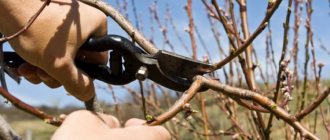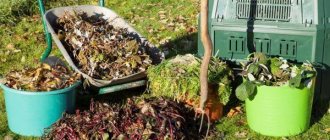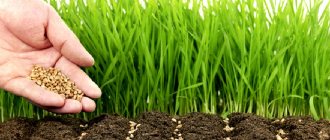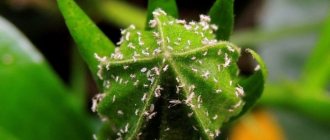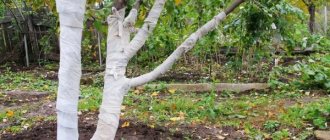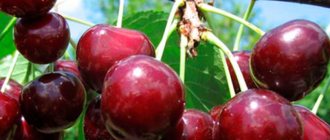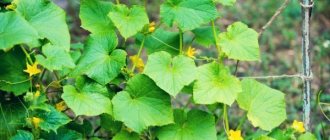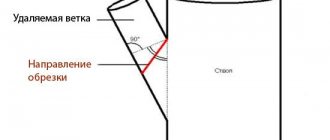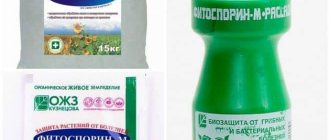How to spray a peach
There is a wide range of chemical and biological preparations for treating plants.
Pesticides for eradication treatments
Eradication treatments are carried out when the plant is dormant. In this case, potent substances are used in shock doses, which is aimed at destroying all wintering pests and pathogens.
DNOC is one of the most effective drugs. It is approved for use only in industrial and farm gardens located no closer than 2 km from a residential area. The permissible treatment interval is once every 3 years. The drug is difficult to dissolve in water, so the working solution for spraying is prepared in two stages:
- 50 g of the drug is thoroughly dissolved in 1 liter of warm water (30–40 o C).
- Pour the concentrated solution into a container with 9 liters of cold water, stirring vigorously.
The drug is highly toxic - 3-5 g is a lethal dose for humans, so you need to work with it using personal protective equipment (PPE) for the skin, eyes and respiratory system.
DNOC is used for eradication treatments of dormant plants no more than once every three years
Nitrafen
Nitrafen is a well-known universal pesticide. The strength of the effect is comparable to DNOC and is used for treatments in those years when DNOC is not used. Frequency of application: once a year.
The concentration for peach is 300 g per 10 liters of water. Due to its toxicity, the use of PPE is mandatory during work.
Copper sulfate (copper sulfate)
Copper sulfate is one of the most well-known and tested plant protection products. In a concentration of 3–5% it is used for eradicating treatments and disinfection of wounds of bark and wood. Weaker solutions (0.5–1%) are suitable for therapeutic and prophylactic spraying in the fight against fungal diseases. To compensate for copper deficiency in a plant, it is fed with a 0.2–0.3% solution of copper sulfate. The chemical is highly soluble, but to prevent the solution from being cloudy, it is prepared in hot water (temperature 50 o C).
Copper sulfate is highly acidic, which is not good for most plants.
Copper sulfate is one of the most famous and tested plant protection products around the world.
Bordeaux liquid
To reduce the acidity of the copper sulfate solution, lime is added to it - the result is the well-known Bordeaux mixture. It is used for the same purposes as pure copper sulfate. This is especially justified when cultivating soil. Preparing a Bordeaux mixture is easy. For this:
- A solution of copper sulfate is prepared in one container, as described earlier, only taking half the required amount of water.
- In another container with the same amount of water, lime milk is prepared by dissolving ground lime in it.
- The vitriol solution is poured into a container with lime milk, stirring continuously.
The vitriol solution is poured into a container with lime milk with continuous stirring.
This solution is short-lived - its effectiveness lasts no more than a day. For eradication treatments, take 300-500 g of lime and vitriol, and for therapeutic and preventive treatments - 50-100 g.
Video: how to prepare Bordeaux mixture
Iron sulfate (ferrous sulfate)
Iron sulfate is a weak systemic fungicide and disinfectant for treating wounds, hollows, and saw cuts. The drug is also used to treat chlorosis caused by iron deficiency. Ferrous sulfate slows down the awakening of the kidneys, which can be useful during a long winter. It is used only when the peach is dormant, otherwise it burns the buds and they dry out. To spray the crown, prepare a 3% solution of the drug, and for disinfection - 6–7%.
If a peach is diagnosed with chlorosis (yellowing of the leaf blades between the remaining green veins), then to treat it you can prepare an iron chelate as follows:
- Dissolve 1 tbsp in 2 liters of soft water. l. citric acid.
- Dissolve 2 tsp in 1 liter of soft water. iron sulfate.
- The second solution is poured into the first in a thin stream with continuous stirring.
Iron sulfate and citric acid are used to prepare iron chelate.
The resulting solution is used immediately after preparation. 4 sprayings will be required at 2 week intervals. To enhance the effect, you can apply root feeding at the rate of 2 l/m2.
Fungicides
Antifungal drugs are addictive to fungi and lose effectiveness after 2-3 treatments. Therefore, they should be alternated.
When alternating drugs, you need to focus on the active substance included in their composition. You should know that different manufacturers often have the same drugs under different names and alternating them is ineffective.
Horus
Horus is a popular fungicide with a limited spectrum of fungi affected. When processing peach, it is effective in the fight against curl, moniliosis and clasterosporiosis. The application temperature range is 3–25 o C. Usually, the cycle of spring treatments (3 per season) on young leaves begins with it. The protective period is 7–10 days, and the waiting period is 10–15 days. The working solution (3 g/10 l) must be used within 2 hours.
Chorus is not washed off by rain if at least 2 hours have passed after treatment.
When treating peach, Horus is effective in combating curl, moniliosis and clasterosporiasis.
Video: how to distinguish counterfeit Horus from the original
Skor is effective against curl and powdery mildew on peach at temperatures from 12 to 25 o C. After using the drug, the foliage of cured plants increases 1.5 times, 15–20% more generative buds are formed for the next season than after treatments with similar means. Therefore, when treating curls that occur in the spring, Skor is an excellent replacement for Horus, which was used for the first treatments. For spraying, dissolve 2 ml of the drug in 10 liters of water. The period of protective action is 2–3 weeks, the waiting period is 3 weeks.
When treating peach leaf curl, Skor complements Horus well.
Strobe
Broad-spectrum fungicide Strobi very effectively and quickly blocks the development of fungi in severe lesions. Acts as an ambulance. Being a contact action preparation, when dried it creates a protective indelible film on the treated surfaces, which decomposes quite quickly in light and air. 3-7 days after treatment, the plant should be sprayed with a strong fungicide in a minimal dose, which will kill the young seedlings of the pathogen, and the old ones will die off on their own. For preventive purposes, Strobi is used after harvesting, and not only the crown, but also the soil around the tree trunks is sprayed.
Fitosporin M universal
Fitosporin M universal belongs to the class of biofungicides, the main active component of which is the live spore bacterium Bacillus subtilis - Bacillus subtilis. It is able to suppress the development of most known fungi and bacteria. In addition, the composition includes humic acids, which play the role of feeding and boosting immunity. Fitosporin is absolutely safe for humans; it can be used even on ripe fruits on the day they are picked. The therapeutic effect of Fitosporin, like most biological drugs, is not sufficiently pronounced compared to chemical ones. But as a means of prevention, this is one of the best means. It can be used repeatedly during the growing season at intervals of 2–3 weeks, since it does not cause addiction in pathogens.
Fitosporin is absolutely safe for humans; it can be used even on ripe fruits on the day they are picked
Urea (urea)
Urea is known as a high nitrogen fertilizer. However, it is also used at the same time for treatments against certain pests (aphids, flower beetles, weevils, copperhead) and fungal diseases (moniliosis, scab, purple spot). Treatments are effective in early spring, as soon as the air temperature rises to 5 o C. The solution is prepared in hot water (600 g of urea per 10 l). An overdose is not dangerous, since the drug does not harm the plant. To enhance the antifungal and insecticidal effect, add 50 g of copper sulfate to the solution.
Urea is not only a nitrogen fertilizer, but also a fungicide
Insecticides and acaricides
Compared to the likelihood of a peach being damaged by fungi, pest attacks are not such a common occurrence. Usually, eradication treatments are quite sufficient for their prevention. If insects do penetrate the plant, several popular and proven drugs are recommended to combat them.
Decis
Decis is good in emergency situations in case of a sudden and massive attack of pests. It acts almost instantly on all harmful (and beneficial) insects. Maintains a protective effect for 15 days after treatment and is not addictive. The waiting period is 30 days. It accumulates in the soil, so its systematic use is not allowed. However, it is occasionally used for prevention in the spring in a tank mixture with Horus.
Decis is good in emergency cases in case of a sudden and massive attack of pests
Iskra-Bio (Akarin)
Iskra-Bio is a biological drug. It affects aphids, various caterpillars, mites and some other pests. Depending on the pest, the dosage of the drug varies:
- Spider mites - 1 ml/l.
- Red fruit mites - 2 ml/l.
- Fruit aphids - 3 ml/l.
- Peach aphid - 8 ml/l.
Pests affected by the drug immediately stop feeding and die of starvation within 2-7 days. Another 2 days are required for the complete removal of drug residues from the fruits, after which they can be eaten.
Fitoverm
Preparations of this brand have a wide range of acaricidal and insecticidal effects. It applies to all feeding insects and mites. After treatment, gnawing pests stop feeding after 6–8 hours, and sucking pests after 12–16 hours. After this, they die of starvation in 2–7 days. It is recommended to carry out a cycle of 2-3 sprays with an interval of 3-5 days. The waiting period is 48 hours.
Ripe peaches can be eaten 48 hours after spraying
Having six peach trees on the plot, after two years of struggle with curl, I came to the conclusion that it is better to regularly carry out eradication treatments in early spring than to subsequently treat the plants with chemicals during the ripening process. By supplementing such treatments with a well-known complex of sanitary and preventive work, I annually obtain good yields of juicy fruits without the use of summer spraying with fungicides.
Timely eradication treatments of peach trees help prevent infection by fungal diseases and pest attacks. In summer, if necessary, it is advisable to use biological preparations that are harmless to humans and animals.
Spraying peach against diseases
Peach is a capricious tree and requires constant attention from the gardener. But if you take proper care of it and carry out agricultural practices in a timely manner, you will be rewarded in the form of juicy large fruits, because the peach is one of the three most delicious fruits in the world, along with orange and mango. But in order to taste the harvest, it is necessary to protect the delicate tree from external enemies: diseases and parasites. The article will tell you when and what kind of processing is necessary for your peach to cope with enemies and produce a harvest.
Wintering without shelter
Only peaches grown in the south can do without shelter. Gardeners in the temperate zone, Siberia and the Urals must necessarily insulate their trees.
If you leave a peach without shelter in regions with harsh winters:
- The branches and roots will freeze. If the tree is weak, young, or the variety is not frost-resistant, the tree may die.
- Bark burns from sunlight. The winter sun can cause damage no less than frost.
- Injury to branches due to snow and ice.
- Bark gnawing by rodents. The consequences of rodent activity depend on the degree of damage. This could be a decrease in yield, disease or death of the tree.
Peach trees require increased attention in our latitudes. If you do not care for it and do not cover it for the winter, it is impossible to achieve good harvests. After spending half an hour insulating the tree, you can count on a harvest of juicy and large peaches.
Peach is a delicate crop with tasty and juicy fruits - such a tree can become the decoration and pride of any personal plot or garden. However, being a heat-loving plant, peach easily takes root in the climate of the southern regions, but requires special conditions and special care in the middle zone. Let us consider below how to properly cover a fruit tree in winter so that it does not die and continues to please the gardener with a rich harvest.
Optimal period for processing
In order for a peach tree to bear fruit, it needs to be helped: care for it, fertilize the soil, water it, and also fight a variety of pests and diseases, of which the peach has many. It is necessary to spray the peach orchard several times a year, since each spraying has a specific task aimed at combating a specific type of pest. Every experienced gardener knows that this tree needs to be treated. Let's take a closer look at processing periods.
Spring
In the spring, it is imperative to process the peach. Spring processing of peaches is carried out several times: before buds open, on the pink bud and finally, after flowering. Each of them has its own tasks, so it will not be possible to treat a peach orchard with one spraying.
The first treatment, early, before buds open, is carried out when the temperature no longer drops below +4 degrees. The goal is to destroy a variety of insects overwintering in the bark of a tree or in its shoots. The procedure is carried out in several stages with an interval of 3-4 days. Fungicides based on copper-containing preparations (Bordeaux mixture, copper sulfate) as well as solarium emulsion are used.
Please note that during this period you should not use urea-based drugs. Since it contains nitrogen, which is an active stimulator of vegetation. If such drugs are used before the buds begin to open, they will speed up the plant’s emergence from dormancy, “waking up” it ahead of time, which can lead to disruptions in the further development of the tree, including loss of harvest.
Spraying during this period also helps in the fight against curl, the most dangerous enemy of the peach orchard. The spores of the fungus overwinter and then reproduce on leaves sprouting from the buds, turning them brown. Young leaves curl, dry out and fall off. As a result, the tree grows worse and does not bear fruit. The same copper-containing preparations help well against this fungus.
Treatment on the rose bud helps fight against various pests, which just at this time emerge from hibernation and begin to destroy young foliage and parasitize the bark. Such spraying is also carried out to prevent dangerous fungal diseases such as powdery mildew, moniliosis or scab. Bordeaux mixture has proven itself well for such operations. Treating it in moderation will not harm your health.
Spraying after flowering is the final stage of spring tree treatment. It has a “fixing” effect, destroying those parasites that survived the previous two stages.
Summer treatment is carried out to combat pests that have invaded the peach. Urea is perfect for this. This fungicide works well against most parasites. You can also use a variety of insecticides in tandem with it. Remember that all spraying work must be stopped 20 days before the crop ripens.
Autumn
Autumn treatment is required to suppress the proliferation of fungal spores, because in the fall the most favorable conditions for the development of fungi are formed - high temperature and humidity. If you do not treat it in the fall, then in the spring the tree will be greeted by millions of new fungal spores that have spread throughout all branches, and fighting them will require significant effort, money and time. Therefore, you should not skip autumn - processing at this time is very important and is done for the future.
It is worth noting that the beginning of the first, spring processing depends on the region where the peach grows. In the southern, warm regions, spraying begins in mid-March, but the further north you go, the start date for the procedure moves closer to April - it all depends on the average air temperature, which should not fall below +4 degrees Celsius. Further spraying is carried out based on observation of the growth and development of the tree - the beginning of the growing season, the appearance of the first foliage, buds, and fruits.
Timing and methods of shelter
The timing of peach insulation for the winter depends on the climatic conditions in the region and on specific weather conditions.
But before starting to insulate the tree, gardeners prepare the peach for winter. Peach trees require special care in the fall. The main autumn activities are pruning and spraying. Having completed all the preparatory work, gardeners begin insulation.
They begin to insulate a tree under the following conditions:
- the leaves on the trees have completely fallen;
- The first frost hit.
Typically, preparatory activities take place from the end of September to the beginning of October. Adjusted for region and weather conditions. Warming is carried out 2-3 weeks later.
An insulated peach has every chance of surviving the winter safely. The main thing is to choose the right method of shelter, corresponding to the level of threats, and remove the insulation in time. If you delay in “uncorking” in the spring, the tree may rot.
The shelter method is selected taking into account the regional climate. Options for covering seedlings and mature trees:
- Warming the roots with humus. Instead of soil, a peat-humus mixture is used for hilling. The soil freezes quickly. And if the winter is not snowy, then the protective layer may not be enough and the roots will freeze. Other materials can be used for mulch.
- Cover with spruce branches or corn stalks. These materials allow you to create a well-ventilated protective layer. Such insulation saves the roots and part of the trunk from cold, rain, sleet, and wind.
- Dropping to the grafting level. This method is used to preserve seedlings. First, they dig a hole about half a meter deep, place seedlings in it at an angle of 45 degrees and dig in with soil. A prerequisite is that the seedlings must be positioned with their tops facing south.
- Thermos style shelter. The covering material is placed around the trunk, leaving a gap between them. The empty space is filled with sawdust. The structure is covered with a film on top to protect the sawdust from getting wet.
- Construction of a “hut”. The tree must be completely covered. All parts of the tree, including the crown, should be in the hut. First, a frame is built, and then covering material is thrown over it. To make the frame, metal hollow tubes or wooden planks are used.
- Agrofibre wrap. The trunk and crown of the tree are wrapped with covering material. To make it easier to wrap the tree, the crown is pre-tied with twine.
A video about covering a peach with spunbond will help you master the insulation technique:
What to spray - preparations
Peaches have a lot of enemies, among them the most dangerous diseases are leaf curl, moniliosis (fruit rot), coccomycosis, clasterosporiosis, and powdery mildew. In addition to diseases, aphids, weevils, oriental codling moths, fruit moths and various mites like to feast on it. To combat parasites, many drugs have been developed, called fungicides (protection against diseases) and insecticides (protection against insects). Let's consider the most popular ones in the fight against pests, spraying with which is most effective:
- urea. Urea, which actively and effectively copes with most harmful insects;
- copper-based fungicides, copper sulfate and Bordeaux mixture, are used to combat most fungal infections;
- fungicide preparations “Abiga-Pik”, “Gaupsin”, “Planriz”, “Skor”, “Trichodermin”, “Khoruz”, “Tattu”. They are used in the fight against most fungal infections;
- insecticide preparations "Aktara", "Enzhio", "Aktellik". The drugs are used against a variety of insect pests;
- diesel emulsion. An effective remedy against insects. If a plant is sprayed with such a mixture, it will become covered with a film that blocks the access of oxygen to various insects overwintering in the bark, causing them to either crawl out or die;
- folk remedies. Tinctures of garlic, lavender or tobacco have long been used against aphids. If you spray a tree with this solution, insects that cannot tolerate the strong aroma of the drug will leave the tree.
Processing technology
To achieve maximum effect, spraying should be carried out according to the rules. If you ignore them, then all your efforts may turn out to be useless - you will waste the solution, but you will not get rid of the pests.
First of all, in the fall, before spraying, clean the garden - collect and burn all the fallen leaves, and also cut off dry and diseased branches, and treat the cut areas with garden varnish. In autumn and spring, spraying is carried out on a quiet, clear, windless day; make sure that it does not rain during or in the next 2-3 days, otherwise it will wash away the chemicals. If this happens, you need to repeat the procedure. It is advisable to spray in the morning, after the dew has evaporated, or closer to sunset, when the weather is calm. In the spring, during the growing season, if there is no dew at night and your garden is lit, the procedure can be carried out at night. It is necessary to achieve as fine a spray of the solution as possible, while treating the entire surface of the tree: trunk, branches, foliage on both sides.
The first spraying in early spring against insects wintering in the bark should be carried out using a watering can with large holes. Thus, we supply the plant with the maximum volume of solution, simply pouring it in so that water can get into even the smallest cracks without having time to be absorbed or evaporate, and at the same time killing all parasites.
It is worth noting that gardeners often use comprehensive measures to combat pests, spraying peach orchards with a mixture of fungicides and insecticides, which destroys both fungal parasites and insects equally well. Also, do not spray with the same preparations - pests quickly adapt. Use different chemicals - the choice of samples offered on the market is quite large.
The ability to start spraying on time by choosing the right preparations can save your peach from death. And knowing the rules of spraying will save you from unnecessary financial expenses for re-purchasing drugs and will help ensure that the peach crop is harvested on time and in full.
Video “Spraying a peach”
This video will show you how to spray a peach.
Shelter rules in different regions
Different regions have their own methods of sheltering. They are selected taking into account the climatic characteristics of the region. The colder the winter, the lower the temperatures and the stronger the piercing winds, the more securely the peach is covered.
Features of peach shelter by region:
- In the southern regions, insulation is limited to hilling. In areas with warm winters, it is enough to rake the soil to the tree trunk. If snow falls, rake it up to the trunk. If there is a risk of roots freezing, instead of soil, a mixture of peat and humus is raked into the tree trunk circle.
- In regions with little snowy winters and moderate frosts, the tree trunk circle is mulched with sawdust mixed with ash. The thickness of the mulch layer is 15 cm. This method of insulation is practiced in the Krasnodar Territory, Rostov Region, and the North Caucasus. Without global shelter, frost-resistant varieties can also overwinter in the Moscow region and the central zone. Less resistant varieties are wrapped.
- In Siberia and the Urals, the most extensive protection methods are used. Here the trees are completely covered using the wrapping method or frame shelters with a crown (hut). A more radical method is also used here - bending down. The tree is first bent to the ground, secured, straw or spruce branches are thrown on top, and in winter the snow is constantly raked up.
Features and diagram of peach pruning in autumn for beginners
The pruning procedure is a very important step in caring for fruit trees, since it is necessary both to extend their life span and to increase the amount of harvest.
Regular removal of excess branches helps to create the most illuminated crown, which provides the following benefits:
- improved ventilation;
- easier harvesting;
- rejuvenation of the tree by removing damaged and dry branches;
- prolongation of productive life;
- stimulating the growth of young shoots and ensuring excellent yields;
- the tree takes on a neat appearance.
By pruning in the fall, the peach is prepared for winter. All necessary actions begin after harvesting the fruits, but no later than mid-autumn. The growing season will already be over by this time. Excision of the root shoots protects against the appearance of harmful insects.
The pruning scheme includes several step-by-step actions:
- It is necessary to cut off the upper branch at the very base.
- Removing the top side shoots that grow from the top branch along the top, leaving a couple of buds on the lower shoots.
- On the branches emerging from the trunk, or on the skeletal ones, it is necessary to leave such a number of buds as to create free space between them for the passage of light.
The number of branches depends on the level of fruiting. The higher the yield, the fewer branches need to be left. As a result, there should be from 80 to 200 branches left on the tree.
After pruning, it is very important to treat the cut areas with garden varnish. In addition, the instrument must be well sharpened and disinfected. It is not recommended to saw off branches. It's better to cut them off in one motion.
Selection of material for insulation
When insulating a peach, a gardener decides two questions: what covering method to use and what material to choose for this purpose. The choice depends on which part of the tree is to be insulated.
Materials for insulation:
- Underground part. To protect the soil from freezing and the roots from freezing, the tree trunk circle is insulated with peat, sawdust or ordinary soil. Less often - manure and sawdust. All these materials cope well with the functions assigned to them, they are accessible and cheap. Typically, gardeners choose the material that they have on hand.
- Aboveground part. The upper part of the tree is wrapped or covered with burlap, agrofibre, spunbond, or plastic film. Spunbond is considered the best of these materials, but its cost is higher than that of its competitors.
- allows you to create a favorable microclimate under the shelter;
- can last several winters;
- This material is easy to work with.
How to fertilize a peach in the fall
Feeding the tree must be carried out along the furrows near the trunk. Fertilizers must be mineral (phosphorus-potassium complexes) and organic:
- young seedlings require feeding with manure or compost (9-10 kg), superphosphate (70-80 g), potassium salt (25-30 g);
- for 3-6 year old trees you need to add manure (14-15 kg), ammonium nitrate (55-60 g), superphosphate (110-115 g), potassium salt (45 g);
- at 6 - 8 years old, the tree needs manure (28-30 kg), superphosphate (170-180 g), potassium salt (65-74 g);
- When fertilizing adult specimens, you should take manure (25-35 kg), ammonium nitrate (115-135 g) and potassium salt (85-105 g).
Experienced gardeners recommend foliar feeding in the fall with a product containing urea.
Autumn watering regime for peach
To retain moisture in the soil, it is necessary to mulch the area around the trunk. In addition, this action helps suppress weeds and prevents the formation of soil crust.
Peaches can tolerate hot climates, provided there is sufficient moisture, so trees need to be watered several times a year: in early spring before flowering, during the period of shoot growth, before fruit ripening.
Autumn moisture-recharging watering, which moisturizes the soil, is necessary for a good wintering of the tree. For 1 square meter of tree trunk area, 5–6 buckets of water are required. If groundwater is present, the volume of water is reduced. To provide the land with air, it is necessary to drain the soil. Final irrigation procedures should be carried out no later than the first days of November.
Rules for preparing peach for winter
Gardeners are constantly busy caring for fruit trees, which are the leaders of their garden plots. Throughout the year, many different activities are carried out aimed at obtaining a good harvest. Autumn work is no less important for preserving the fruit tree.
Digging and mulching tree trunk circles
The part of the earth located near the tree trunk, equal in diameter to the crown, is called the trunk circle. The process of mulching a given plot of land serves not only as an environmentally friendly design method, but also performs a number of other functions :
- decoration of the tree trunk circle;
- moisture retention;
- preventing the growth of weeds;
- introducing additional nutrients for the root system.
Materials for mulch can be:
- peat;
- fallen needles;
- sawdust;
- crushed bark;
- cones, cedar husks or other natural ingredients.
The thickness of the mulch layer should be at least 5 cm. To prevent the plant from starting to rot, it is necessary to leave a distance from the trunk to the mulch. This will allow air to circulate.
In order for a garden crop to survive the winter well, it is very important to properly treat the soil. Deep digging of the soil (no more than 10 cm) allows you to destroy the pests in it. At the same time, you need to take into account that the lumps should not be broken. You need to dig the ground no closer than 0.5 m from the trunk, otherwise you can damage the surface root system.
How to cover a peach for the winter (video)
Sheltering a young peach for the winter
The peach tree is very afraid of temperature changes, so to avoid the death of the buds or tree, proper preparation for winter is necessary. To preserve heat, the young tree needs to be covered.
- The first stage of work begins after leaf fall. It involves bending the seedling to the ground. The temperature must be above zero so that the branches do not become brittle.
- In order to spend less material on shelter, you should bend the tree as low as possible. The first step is to choose the side where it is better to persuade him. Then pegs are driven in, to which the rope is attached. Small branches are connected all together and tied to the main branch. At the same time, all actions must be careful so as not to break anything.
- Since old branches are difficult to deform, they can be cut off. Damaged areas should be lubricated with varnish.
- To protect against mice, which in winter can settle in the shelter and damage the tree bark, you need to place a special repellent in the center of the bush.
- After snow falls, you need to sprinkle it on the tree to create a snowdrift up to 25 cm.
- Instead of snow, you can use dry material, such as sawdust or other bulk materials (straw, old tops). Place plastic film or roofing felt on top.
When covering a fruit tree, it is important not to use very dense material, under which the tree can dry out.
Purpose and rules for spraying peach in autumn
To maintain the health of the tree and produce large fruits, it must be protected from external enemies. Spraying will help against diseases and parasites.
Autumn is a great time for fungal growth. Treatment will help destroy fungal spores so that by spring they do not spread to all branches. Then fighting them will take much more time and effort.
To achieve maximum effect, you must adhere to the established rules:
- the first step is to remove all fallen leaves and trim unnecessary branches;
- the day must be clear and calm, otherwise the rain will wash away all the chemicals;
- It is advisable to choose morning or evening hours for spraying;
- The spray should be fine and cover all parts of the plant.
By following all the recommendations, you can save yourself from additional costs for repeated spraying.
Protecting peach from sunburn
Due to sudden changes in ambient temperature and unfavorable winter conditions, damage called sunburn may appear on wood. All parts of the tree can receive such wounds, and at any time of the year.
To prevent burns, in addition to sheltering for the winter, it is necessary to properly water the tree and fertilize the soil. Before the onset of cold weather, the trunks and bases of skeletal branches must be whitened with slaked lime. To improve the effect, the tree should be sprayed with lime milk.
How to protect a peach from rodents in winter
It is necessary to protect fruit trees not only from frost, but also from rodents, otherwise the peach will die. There are 2 methods of protection:
With the mechanical method, various materials are tied around the tree trunk and its branches (special nets for protection against rodents, roofing felt, coniferous spruce branches). When using dense materials, in order to avoid the formation of condensation, they must be removed during a thaw.
Trees can be treated with special repellent compounds. For example, a mixture of clay and cow manure with the addition of carbolic acid at the rate of 1 tablespoon per bucket of the mixture. A good rabbit repellent is a mixture of fish oil and naphthalene in a ratio of 8:1.
Cold protection
Peach is a rather “delicate” fruit plant and does not tolerate sudden changes in temperature with heavy rainfall. Therefore, in the winter, protect both the crown, the trunk, and the basal collar with roots from the cold. The intensity of plant cover depends on the climatic conditions of the place of growth.
Basically, they cover it with burlap, wrapping it around the seedling. In regions with a particularly harsh climate for fruit plants, you can use this method of shelter:
- the branches are tied with twine;
- tied to the trunk, a hut is built from sticks fastened at the top with screws;
- the entire structure is wrapped in mineral wool and covered with polyethylene to protect it from getting wet;
- on the south side you can additionally cover it with slate to avoid sunburn.
When the sun becomes active, the entire structure is dismantled to prevent rotting.
During wintering, the peach tree risks not only freezing, but also getting burned by ultraviolet radiation. In this case, not only the bark is damaged, but the entire tree. The reason for this may be insufficient watering. According to statistics, young seedlings suffer especially often from burns.
Attention!
To avoid burns from ultraviolet radiation, it is necessary to bleach the trunk and base of skeletal and fruiting branches.
Whiten with slaked lime. In addition to this, you can spray the branches of the peach tree with lime milk.
